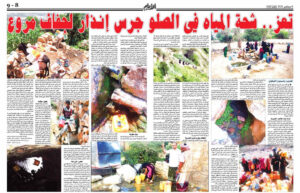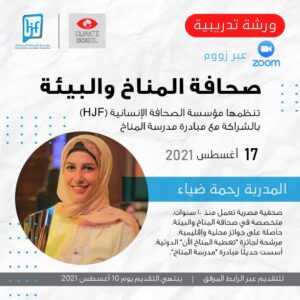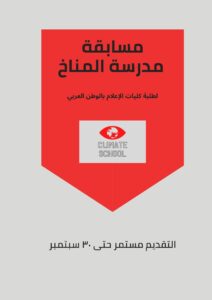Written by: Rahma Zia
Quoted from the “For Information” website.. Link to the original report published in November 2022 here
A study that monitors internal movement from the areas of Sugar Beet, Al-Hamam, and Al-Zamam on the northern coast...and an international report expects internal climate migration to exceed 10 million by 2050.
Entire villages were abandoned by their people due to floods, and families from various countries moved internally and externally in search of a livable life after the lands dried up, the animals died, fishing became impossible, and the beaches eroded as a result of climate change, and millions of displaced people annually became known as “climate migrants.” The number of internally displaced people due to climate reached 17.2 million people worldwide, according to Estimates center monitoring Displacement InternalWhile expectations indicate that the number may rise to 143 million people by 2050, according to the bank International.
International reports expect similar future migrations in Egypt, estimated at millions, while limited local studies have monitored an internal movement that has already begun as a result of drought, high temperatures, and fluctuating rainfall, which has harmed the crafts of agriculture, fishing, and herding, and pushed their owners to leave their governorates in search of their daily bread.
And she points Estimates The Intergovernmental Panel on Climate Change indicates that by 2050, Mediterranean sea levels are expected to rise by one meter as a result of global warming, resulting in the loss of a third of the highly productive agricultural land in the Nile Delta, and the inundation of some cities along the northwest coast, such as Alexandria. Damietta, Rasheed, and Port Said, and the movement of more than 10 million people to the already densely populated Nile Valley region, according to what was reported in a report Human Development for 2021 issued by the United Nations Development Program in cooperation with the Ministry of Planning and Economic Development.
Labor migration
Ahmed Kamel (51 years old) inherited the craft of agriculture from his father, in addition to 22 acres that he shares with eight brothers and four sisters. It was once one of the best lands in the village of Ali Pasha Al-Roumi, affiliated with the Youssef Al-Siddiq Center in Fayoum Governorate on the outskirts of Upper Egypt, before its wealth dried up and dried up. The brothers abandon agriculture and their homes and part their ways in pursuit of livelihood in other governorates.
Kamel told “For Information”: I had no alternative to being able to support my wife and children other than to leave. I moved to Giza Governorate and worked as a security guard for one of the properties after I had been the owner of a land and a house. We did not easily get used to our new situation, and we endured difficult situations, and on top of that, we Strangers, far from family and neighbors.
Kamel's siblings and their children, in turn, immigrated to Greater Cairo; They are currently distributed among the assembly areas, Mokattam, and 6th of October City, and work in the fields of real estate security, construction, and concrete works.
A study monitoredthe cost Environmental And economic For desertification in Lands Fayoum“ Fayoum Governorate lost more than 12 thousand agricultural acres between 1987 and 2018, resulting in losses estimated at 146 million pounds.
Climate change
Adel Motamed, professor of environmental geography at Assiut University, and author of the study, told “For Information”: Fayoum Governorate is one of the most important sources of internal migration of the population. Due to the deterioration of the condition of agricultural lands and the decrease in their productivity as a result of several factors, including the change in temperature values, the rise of which is linked to a clear increase in evaporation rates, the soil loses much of its moisture and increases the levels of the salinization process, in addition to the nature of the dry climate in the region, and other factors not related to climate change that contributed. The situation is exacerbated by poor irrigation water management.
“Motamed” pointed out that “there are similar effects that lead to internal movements of residents of lands dependent on groundwater, such as New Valley Governorate, as well as residents of lands on the northwestern coast of Marsa Matrouh Governorate.” Due to irregular rainfall, which leads to the failure of agricultural operations that rely primarily on rainwater.”
This is what farmers and grazing workers in Marsa Matrouh Governorate have been suffering from for years due to drought and lack of rain, which has led to the disappearance of some types of pastoral plants that are palatable to animals, according to Mustafa Moussa, Chairman of the Board of Directors of Al-Rams Association for Local Community Development of Pastures and Environment in Matrouh Governorate.
Musa added to “For Information”: “The owners of the herds were unable to meet their needs with the deterioration of pastures as a result of climate change in the region, in addition to the rise in the price of manufactured fodder. The price of a ton reaches 10 thousand pounds, and as a result, internal migration occurred, and there are those who abandoned the entire profession.”
He pointed out that “there are several projects implemented in the region in cooperation with the association aimed at multiplying pastoral seeds such as acacia and clover, creating natural reserves, and providing support to women through small projects to raise birds and livestock to improve their livelihood,” adding: The government supports and the projects help, but the climatic conditions are... Lack of rain, storms and extreme cold are all against us.
Pastoral genres
For his part, Mustafa Sabry Al-Hakim, professor of natural pastures at the Desert Research Center, and coordinator of the project to collect and preserve seeds of rare pastoral plants in Matrouh Governorate, told “For Information”: Drought and fluctuating rainfall, in addition to overgrazing, contributed to the deterioration of natural pasture lands on the northwestern coast. And the disappearance of some good and highly palatable pastoral species for animals, which led to the herders moving to governorates near the coast, such as Beheira and Siwa Oasis. He pointed out that the seed collection project (was implemented from 2012 to 2015 with funding from the Small Grants Programme, the Global Environment Facility, and the Research Center Desert, and implemented by Al-Rams Association) aimed to improve degraded grazing areas by collecting seeds, re-seeding, and preserving palatable pastoral species from extinction. Various segments of society, including men, women, and youth, participated in its implementation, which helped improve their capabilities, especially in times of drought or fluctuating rainfall. .
Al-Hakim pointed out that we need to conduct in-depth studies into the social impacts of climate change that lead to the migration of some types of workers, especially in desert areas.
Limited studies
A limited number of studies have monitored internal migration due to climate change in Egypt, including the study “Internal displacement resulting from climate change in the regions of Sugar Beet and Al-Hamam on the northwest coast,” which was carried out by the Arab Network for Environment and Development “Raed” in cooperation with the Norwegian Refugee Council in Egypt and Sudan between 2007 and 2017. 2013-2015 (the report’s author obtained a printed copy of it), and the study monitored the spread of the phenomenon of drought and the deterioration of agricultural lands in the villages of Sugar Beet and Al-Hamam as a result of several reasons, including the decline in rainfall amounts and their fluctuation, which leads to high rates of salinity and a rise in temperature, which led to a change in Planting time is within 15 days.
The study indicated that due to farmers' limited knowledge of the consequences of climate change and its impact on agriculture, they continued to plant on the same old dates, which led to a reduction in crop productivity by rates of up to 30% in many regions.
The study recorded several social impacts as a result, including the displacement of numbers of residents in search of earning opportunities or a better life, and the desire of residents to switch from agriculture to other professions such as drivers and sellers.
The study also indicated other effects of climate change in Egypt on population centers, in addition to the migration of agricultural labor, which is the migration of fishermen as a result of the impact of fish production due to the change in ecosystems in coastal areas and the rise in sea water temperature, with future expectations of the migration of residents of the low-lying areas in the northern Delta and some Other coastal areas are threatened by submergence as sea levels rise, increased rates of beach erosion, salt water penetration into the soil, and decreased agricultural productivity.
Community awareness
Ghada Ahmadin, director of programs at the “Raed” network, told “For Information”: The most important recommendation that came out of the study is the necessity of involving the local community affected by the consequences of climate change in proposing solutions, including youth and women. To enhance community resilience and help residents withstand risks, thus reducing displacement.
Ahmed added that displacement due to climate does not have to result from a major disaster such as torrents and floods, but factors such as drought and lack of rain also have a strong impact on the internal movement of residents, and she pointed out that we need more projects aimed at building communities’ capacity for resilience and resistance.
Women's migration
In turn, Ahmed Al-Droubi, Director of Campaigns at Greenpeace, told “For Information”: The main problem with regard to climate migration is the absence of information about it. Because there was no monitoring and documentation of internal migration processes in Egypt, then dealing with them and trying to find solutions for them, and he adds: “We need to have networking between various sectors to monitor the intersectional impacts of climate change and provide a greater role for civil society and involve the most affected and marginalized groups because they are more capable of knowing the solutions.” that suits them and improves their situation.”
Al-Droubi pointed out that women are among the groups most affected by climate migration, and there must be encouragement for the presence of civil society organizations working to support feminist issues intersecting with climate change, and there must be awareness-raising work and the development of gender-sensitive solutions and adaptation measures.
And he agreed Statements Michelle Bachelet - United Nations High Commissioner for Human Rights - “Women represent approximately 80% of those displaced due to climate change, and that displaced women are more at risk of violence, including sexual violence, especially those displaced in emergency shelters or tents,” noting “the risk “The increasing human trafficking, child, early and forced marriages endured by women and girls on the move.”
Cases of internal migration often lead to girls getting married early and dropping out of education, according to Abdel Hamid Hussein (39 years old), a former farmer who was forced by climatic conditions to emigrate from his profession and his country in the Minya Governorate and move to Greater Cairo to work as a property guard in the Hadayek Al-Ahram area in the Al-Ahram Governorate. Giza.
Hussein says to “For Information”: When we moved here, our circumstances were difficult, and I did not have the means to spend on girls’ education in addition to living expenses. My eldest daughter left school when she was in the fourth grade of primary school, and my younger daughter was in the third grade of primary school. Circumstances only allowed me to send my youngest son to school, and I wished that all my children would be educated so that they could live in better conditions than what I experienced.
Resilience
recommend guide “Disaster Displacement: How to Reduce Risk, Address Impacts and Enhance Resilience,” issued in 2018 by the United Nations Office for Disaster Risk Reduction, by making information about drought, floods, and other damages resulting from climate change available to communities; Because this would help them make decisions to reduce economic losses and thus reduce internal displacement. He also recommended the need to establish preparedness and early warning systems, and organize migration processes related to climate change by the authorities to provide protection and support, especially for the most vulnerable groups such as the elderly. women and children, and that planned, organized migration processes would help the population return to their cities as soon as possible.
There are local experiences that have confirmed this, including the national project for lining canals, launched by Egypt to confront the water shortage crisis and ensure better access of water to the ends of the canals. It is being implemented in 19 governorates, and implementation is expected to be completed in 2030, according to location information General Association.
Salem Shaheen (45 years old), a farmer and Chairman of the Board of Directors of the Joint Cooperative Society in the Youssef Al-Siddiq Center in Fayoum, told “For Information”: “The canal lining project that was implemented in Fayoum Governorate and which the farmers followed in lining the internal canals contributed to the arrival of water that was not It reached the finals of canals at the governorate level, and this resulted in the return of many landowners who had abandoned them for many years to the city in search of a source of livelihood. When things improved, especially irrigation water, people returned to their country again and cultivated their lands.”
This is what happened with farmer Ahmed Kamel, whose story we started the report on. After years of diaspora, he returned to his land two years ago, and he tells “For Information”: After the project was implemented and irrigation water reached the lands, I was encouraged to return, and I made a great effort to make the land return to being fertile. Praise be to God, I planted two seasons of wheat and the land has returned to goodness, but my brothers and their children still reside in Greater Cairo. Reconstructing the land is not easy, and requires large costs, but, God willing, we will replant the entire 22 acres, my brothers and their children will return to our country, and our family will be reunited again.





